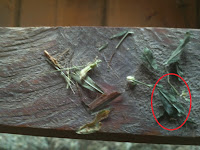Look for:
- Green color
- Thin soft stems
- Good smell - it should smell sweet, not dusty and dirty
- Mold. Here is a good article with a picture of mold.
- Weeds. Anything that isn't hay. If it doesn't look like grass or alfalfa it isn't. I have one producer that likes to try and sneak in bales of weeds from the edge of the field with the hay delivery each year and claim that it's just fine. I'll try to get a picture next time I see it.
- Brown color. This means the hay has been left out in the sun and rain and has lost a great deal of it's nutrients. It may be green on the inside, but the rain has coursed through it and taken nutrients away in the process.
- Too heavy. If you know about what a bale should weigh and the ones you're looking at are much heaver, the hay may be too moist and prone to mold.
- Seed heads. This is minor, but once a grass has started to produce seeds it has lost some of it's nutrition value by producing the seeds. Yes, the nutrition is in the seeds, but in a different form (sugars) that's not as good for horses. It's not a deal breaker, but seed heads means it was harvested too late.
 |
| Local Grass Hay |
This is a term people use for a variety of hay grown locally. Most of the time this is a thin leaved grass hay. The stems are soft. It's lower in nutrition value per pound than something like Timothy Hay hay but has more fiber. It's a great foundation for a healthy horse diet. They can eat plenty and not get fat. It has the nutrients they need. It keeps them happy because they can munch on it longer if they get more. Because it's local, it's usually less expensive than other types, but more expensive than weeds or low quality hay.
 |
| Timothy Hay with Seed Head Circled |
Technically these are different hays, but each is a leafy nutritious hay that's high in fiber. The leaves are wide and the stems are short and soft. It's a good foundation for a healthy horse diet. The downside of this hay is that the easy keepers may get fat on it because it's a little more nutritionally dense than the local grass hay. My horses preferred this to their regular local grass hay and a good grass/alfalfa mix in a taste test.
I circled the seed head so you can compare to the slough hay below.
Oxbow has some good detailed information on the differences and nutrition value of some of these types of hay. Where I live, Oxbow is cost prohibitive to buy for horses but it's great for pet rabbits and other small animals.
Grass Hay Alfalfa Mix
 |
| Alfalfa Leaves |
 |
| Grass Hay Alfalfa Mix |
Pure Alfalfa
This isn't good for horses. Cows can digest the high levels of protein in alfalfa, but horses have a hard time with it. You can identify it because there are no long grassy leaves in the bale. It's usually greener than grass hay. I will add a picture when I can.
 |
| How to identify Slough Hay |
It looks like good hay, right? This isn't really hay, but someone may try to sell it to you as such. It's reed canary grass that grows on the edge of wetlands. Horses don't like it and if they don't like it, they won't eat it unless they're very hungry. It looks like good leafy hay, but there are some subtle differences you can use to identify it. The leaves are long and wide and the stems are long, golden and stiff. The easiest to spot difference is that the seed heads are branched instead of single stemmed like you see in the Timothy hay picture.
Weeds
 |
| Weeds |